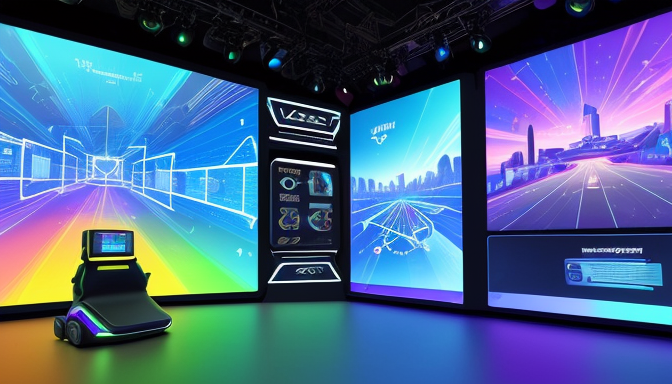Welcome to the thrilling realm of immersive virtual experiences, where reality bends and the impossible becomes possible! Imagine stepping into a world where you can explore the depths of the ocean, soar through the skies, or even walk on Mars, all from the comfort of your living room. This is not just a dream; it’s the magic of Virtual Reality (VR), Augmented Reality (AR), and the ever-evolving metaverse. These technologies are transforming how we interact with digital content, creating experiences that are not only engaging but also profoundly impactful.
The advancements in VR and AR technologies are nothing short of astounding. With high-resolution displays, motion tracking, and haptic feedback, users can feel as if they are truly part of the action. The metaverse, an interconnected universe of virtual spaces, is redefining social interaction and entertainment. It’s like stepping into a digital playground where the rules of reality don’t apply, inviting users to unleash their creativity and connect with others in ways previously unimaginable.
As these technologies continue to develop, the possibilities are endless. Whether it’s gaming, education, or therapy, immersive experiences are set to revolutionize our lives. They offer a unique blend of learning and fun, making education more engaging and therapy more effective. So, are you ready to dive into this captivating world? The future is here, and it’s more exciting than ever!
The Technology Behind Immersive Experiences
In the ever-evolving realm of technology, immersive experiences have taken center stage, captivating users with their ability to transport them into fantastical worlds. At the heart of this revolution lies the metaverse, a digital universe that blends reality with the virtual. Imagine stepping into a world where the boundaries of imagination are limitless—this is the promise of the metaverse.
Virtual Reality (VR) and Augmented Reality (AR) are the dynamic duo fueling this transformation. VR immerses users in a fully digital environment, while AR overlays digital elements onto the real world. These technologies are not just gimmicks; they are reshaping how we interact with digital content. For instance, VR headsets like the Oculus Rift and HTC Vive enable users to engage in lifelike experiences, whether that’s exploring distant planets or participating in thrilling adventures.
Moreover, the advancements in hardware and software are staggering. High-resolution displays, motion tracking, and haptic feedback systems create a sensory feast that feels incredibly real. Developers are continuously pushing the envelope, utilizing powerful game engines like Unity and Unreal Engine to craft stunning visuals and interactive experiences.
As we dive deeper into this technological landscape, it’s clear that the future of immersive experiences is not just about entertainment; it’s about creating connections, enhancing education, and revolutionizing industries. With the right tools and creativity, the virtual realm is set to become an integral part of our daily lives.

Applications in Various Industries
Immersive virtual experiences are reshaping the landscape of multiple industries, bringing a fresh wave of innovation that captivates users like never before. Imagine stepping into a metaverse where you can interact with your friends in a virtual café, attend a concert from the comfort of your living room, or even explore ancient ruins without leaving your home. The possibilities are endless!
In the realm of gaming, developers are creating rich, interactive worlds that engage players on a whole new level. Games like Beat Saber and Half-Life: Alyx are not just games; they are experiences that immerse players in thrilling narratives. But it doesn’t stop there! The education sector is also harnessing this technology. Imagine a classroom where students can explore the human body in 3D or travel back in time to witness historical events firsthand. This kind of engagement not only enhances learning but also makes it more enjoyable.
Moreover, industries like healthcare are leveraging virtual reality for training and therapy. Medical students can practice surgeries in a risk-free environment, while patients can undergo exposure therapy for phobias in a controlled setting. The use of augmented reality (AR) in architecture and design allows professionals to visualize projects before they are built, making the planning process more efficient and collaborative.
As we dive deeper into this digital age, the integration of immersive experiences is set to revolutionize how we interact, learn, and entertain ourselves. The future is bright, and it’s time to embrace the change!
Frequently Asked Questions
- What is immersive virtual experience?
Immersive virtual experience refers to a simulated environment that engages users in a way that feels real. It often involves technologies like virtual reality (VR) and augmented reality (AR) to create lifelike interactions and experiences.
- How does immersive technology work?
This technology combines advanced hardware, such as VR headsets and motion sensors, with sophisticated software to create interactive environments. Think of it as stepping into a video game where you can actually look around and interact as if you were inside the game!
- What industries benefit from immersive experiences?
Immersive experiences are making waves in various sectors! From gaming and entertainment to education, training, and therapy, the applications are vast. They enhance engagement and can lead to better learning and retention.
- Can immersive experiences improve learning outcomes?
Absolutely! By simulating real-world scenarios, immersive experiences can make learning more engaging and effective. Imagine studying history by virtually walking through ancient cities instead of just reading about them!
- Are immersive experiences accessible to everyone?
While technology is becoming more accessible, not everyone has the latest VR gear. However, many platforms are working to create experiences that can be enjoyed on various devices, making it easier for more people to participate.